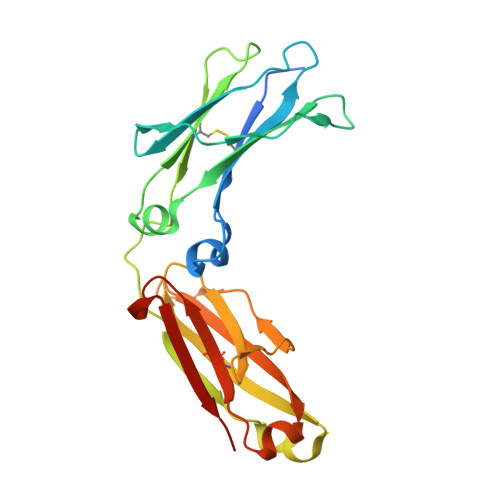Structural differences between glycosylated, disulfide-linked heterodimeric Knob-into-Hole Fc fragment and its homodimeric Knob-Knob and Hole-Hole side products.
Kuglstatter, A., Stihle, M., Neumann, C., Muller, C., Schaefer, W., Klein, C., Benz, J.(2017) Protein Eng Des Sel 30: 649-656
- PubMed: 28985438
- DOI: https://doi.org/10.1093/protein/gzx041
- Primary Citation of Related Structures:
5HYE, 5HYF - PubMed Abstract:
An increasing number of bispecific therapeutic antibodies are progressing through clinical development. The Knob-into-Hole (KiH) technology uses complementary mutations in the CH3 region of the antibody Fc fragment to achieve heavy chain heterodimerization. Here we describe the X-ray crystal structures of glycosylated and disulfide-engineered heterodimeric KiH Fc fragment and its homodimeric Knob-Knob and Hole-Hole side products. The heterodimer structure confirms the KiH design principle and supports the hypothesis that glycosylation stabilizes a closed Fc conformation. Both homodimer structures show parallel Fc fragment architectures, in contrast to recently reported crystal structures of the corresponding aglycosylated Fc fragments which in the absence of disulfide mutations show an unexpected antiparallel arrangement. The glycosylated Knob-Knob Fc fragment is destabilized as indicated by variability in the relative orientation of its CH3 domains. The glycosylated Hole-Hole Fc fragment shows an unexpected intermolecular disulfide bond via the introduced Y349C Hole mutation which results in a large CH3 domain shift and a new CH3-CH3 interface. The crystal structures of glycosylated, disulfide-linked KiH Fc fragment and its Knob-Knob and Hole-Hole side products reported here will facilitate further design of highly efficient antibody heterodimerization strategies.
Organizational Affiliation:
Therapeutic Modalities, Roche Innovation Center Basel, Grenzacherstrasse, 4070 Basel, Switzerland.















